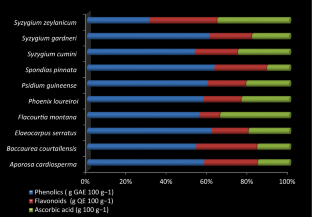Underutilised fruits of Agasthyamala Biosphere Reserve: a potential source of natural antioxidants
Research Articles | Published: 08 March, 2021
First Page: 447
Last Page: 452
Views: 3540
Keywords: Agasthyamala Biosphere Reserve, Antioxidants, Ascorbic acid, Flavonoids, Phenolics, Underutilised fruits
Abstract
Antioxidant properties of commercial fruits are well investigated however there is little information available about such properties of underutilised fruits. The present study evaluated the antioxidant potential of ten underutilised edible fruits viz., Aporosa cardiosperma (Gaertn.) Merr., Baccaurea courtallensis (Wight) Müll.Arg., Elaeocarpus serratus L., Flacourtia montana J. Graham, Phoenix loureiroi Kunth, Psidium guineense Sw., Spondias pinnata (L.f.) Kurz, Syzygium cumini (L.) Skeels, Syzygium gardneri Thwaites and Syzygium zeylanicum (L.) DC. from the Kerala part of Agasthyamala Biosphere Reserve. Total phenolic content was determined through Folin–Ciocalteau method, flavonoids by aluminium chloride colorimetric method, ascorbic acid by titrimetric method and antioxidant activity was measured by DPPH radical scavenging assay. Free radical scavenging potentials of the evaluated underutilised fruits were found to be proportional to their respective phenolic, flavonoid and ascorbic acid contents. Amongst all the fruits analysed, Elaeocarpus serratus L., Psidium guineense Sw., Syzygium gardneri Thwaites and Baccaurea courtallensis (Wight) Müll.Arg. exhibited significantly high antioxidant activity and can be explored as viable source of natural antioxidants for functional food and pharmaceutical applications.

References
- Blomhoff R (2005) Dietary antioxidants and cardiovascular disease. Curr Opin Lipidol 16:47–54
- Bors W, Heller W, Michel C, Saran M (1990) Flavonoids as antioxidant: determination of radical scavenging efficiencies. Methods Ezymol 186:343–355
- Cai Y, Sun M, Corke H (2003) Antioxidant activity of betalains from plants of the amaranthaceae. J Agric Food Chem 51:2288–2294
- Gyamfi MA, Yonamine M, Aniya Y (1999) Free- radical scavenging action of medicinal herbs from Ghana: Thonningia Sanguinea on experimentally-induced liver Injuries. Gen Pharmacol 32:661–667
- Hodgkinson A (1977) Oxalic acid in biology and medicine. Academic Press, London
- ICMR (2010) Nutrient requirements and recommended dietary allowances for Indians. A report of the expert group of the Indian Council of Medical Research. National Institute of Nutrition, Hyderabad
- IP (2014) Indian pharmacopoeia, 7th edn. Indian Pharmacopoeia Commission, Ghaziabad
- Jayasri MA, Mathew L, Radha A (2009) A report on the antioxidant activities of leaves and rhizomes of Costus pictus D. Don Int J Integr Biol 5:20–26
- Kanti BP, Syed IR (2009) Plant polyphenols as dietary antioxidants in human health and disease. Oxid Med Cell Longev 2:270–278
- Khadabadi SS, Deore SL, Baviskar BA (2013) Experimental phytopharmacognosy a comprehensive guide. Nirali Prakashan, Pune
- Kim D, Jeond S, Lee C (2003) Antioxidant capacity of phenolic phytochemicals from various cultivars of plums. Food Chem 81:321–326
- Leong LP, Shui G (2002) An investigation of antioxidant capacity of fruits in Singapore markets. Food Chem 76:69–75
- Marin FR, Martinez M, Uribesalgo T, Castillo S, Frutos MJ (2002) Changes in nutraceutical composition of lemon juices according to different industrial extraction systems. Food Chem 78:319–324
- Nataraj L, Sellamuthu M (2010) In vitro antioxidant properties of indigenous underutilized fruits. Food Sci Biotechnol 19:725–734
- Nayar TS, Rasiya Beegam A, Mohanan N, Rajkumar G (2006) Flowering plants of Kerala. Jawaharlal Nehru Tropical Botanic Garden and Research Institute, Palode
- Rajan S, Gokila M, Jency P, Brindha P, Sujatha RK (2011) Antioxidant and phytochemical properties of Aegle marmelos fruit pulp. Int J Curr Pharm Res 3:65–70
- Salah N, Miller NJ, Panganga G, Tijburg L, Bolwell GP, Rice-Evans C (1995) Polyphenolic flavanols as scavengers of aqueous phase radicals as chain-breaking antioxidants. Arch Biochem Biophys 322:339–346
- Sasidharan N (2004) Biodiversity documentation for Kerala. Part 6: Flowering plants. Kerala Forest Research Institute, Peechi
- Tomas BF, Espin JC (2001) Phenolic compounds and related enzymes as determinants of quality of fruits and vegetables. Jour Sci Food Agric 81:853–876
- Tomita IN, Manzoli A, Fertonani FL, Yamanaka H (2005) Amperometric biosensor for ascorbic acid. Eclet Quím 30:37–43
- Uddin SN, Akond MA, Mubassara S, Yesmin MN (2008) Antioxidant and antibacterial activities of Trema cannabina. Middle-East J Sci Res 3:105–108
- Valko M, Leibfritz D, Moncol J, Cronin MT, Mazur M, Telser J (2007) Free radicals and antioxidants in normal physiological functions and human disease. Int J Biochem Cell Biol 39:44–84
- Wolfe K, Wu X, Liu RH (2003) Antioxidant activity of apple peels. J Agric Food Chem 51:609–614
Author Information
Research and Development Centre, Bharathiar University, Coimbatore, India